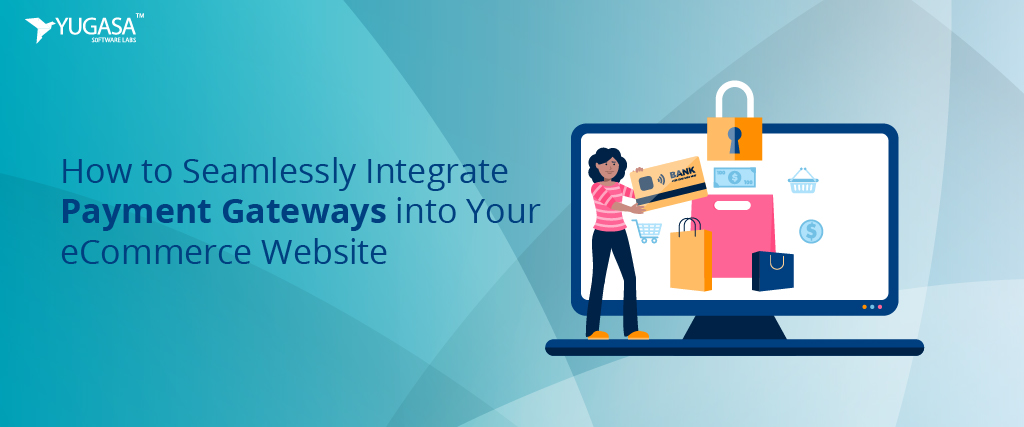Introduction
In the digital World, the success of an eCommerce business hinges significantly on its ability to process online payments efficiently and securely.
Payment gateways are the cornerstone of this process, acting as the bridge between an online store and the financial institutions that process transactions.
As eCommerce continues to flourish, understanding and integrating the right payment gateway becomes imperative for business growth and customer trust.
What is a Payment Gateway?
Online merchants use payment gateways, a secure technology, to process customer credit and debit card transactions.
It serves as the bridge between a merchant’s website and their payment processor, facilitating the movement of payment information during eCommerce transactions.
When a customer submits payment details on a merchant site, the payment gateway encrypts and transports this sensitive data to payment networks like Visa or Mastercard.
It handles the entire authorization process seamlessly behind the scenes, ensuring compliance and security.
Once approved, funds can be transferred into the merchant’s bank account.
Without a payment gateway, merchants would not be able to accept online card payments directly on their websites or apps.
It is an essential component of the digital payment infrastructure.
The Role of Payment Gateways in eCommerce Transactions
In eCommerce transactions, payment gateways fulfill several crucial roles:
- Encrypt sensitive card data so it can be transmitted securely between the customer and the merchant’s bank. This prevents fraud and theft.
- Act as the intermediary between merchant websites and banks/payment processors by facilitating communications between them.
- Integrate with payment processors to connect merchants to card networks like Visa and Mastercard. This grants access to the global payment rails.
- Handle fraud analysis by using algorithms to screen transactions for suspicious patterns. This identifies potential fraud before orders are fulfilled.
- Provide tools and interfaces for merchants to monitor and manage transactions from authorization to settlement.
- Ensure compliance with industry security standards and protocols like PCI DSS.
By fulfilling these roles, payment gateways enable the smooth, reliable flow of payments between merchants and customers. They are a foundational component of modern online commerce.
Types of Payment Gateways
Hosted vs. Integrated Payment Gateways
- Hosted Payment Gateways: These gateways redirect your customers to an external payment processor’s page (like PayPal) to complete the transaction. This off-site processing simplifies the security requirements for the merchant but can disrupt the customer’s shopping experience.
- Integrated Payment Gateways: These are incorporated directly into the eCommerce site, allowing customers to complete the transaction without leaving the website. They offer a seamless checkout process but require the merchant to handle security and compliance responsibilities.
Pros and Cons of Each Type
- Hosted Gateways: Pros include enhanced security handled by the gateway provider and ease of integration. Cons involve potential customer trust issues due to redirection and possible impact on conversion rates.
- Integrated Gateways: Pros include a seamless user experience and greater control over the checkout process. Cons involve the need for stringent security measures and compliance with PCI DSS standards.
Choosing the Right Payment Gateway
Factors to Consider
Choosing the best payment gateway involves carefully evaluating multiple aspects, such
- Security: Ensuring the gateway adheres to the highest security standards like PCI DSS compliance is non-negotiable.
- Transaction Fees: Understanding the fee structure, including any hidden costs, is crucial for budgeting.
- Compatibility: The gateway should integrate seamlessly with your existing eCommerce platform.
- Customer Preferences: Consider the payment methods preferred by your target audience.
Overview of Popular Payment Gateways
- PayPal: This option is widely accepted by customers and easy for merchants to integrate.
- Stripe: Offers extensive customization options and is ideal for international transactions.
- Amazon Pay: Integrates well with various eCommerce platforms and is known for its user-friendly interface.
Integration Process
General Steps for Integrating a Payment Gateway
- Choose a Payment Gateway: Based on your business needs and customer preferences.
- Set Up a Merchant Account: Some gateways require a separate merchant account, while others like Stripe offer combined services.
- Obtain API Keys: These keys will connect your website to the payment gateway.
- Integrate the Payment Gateway: This might involve adding plugins or writing custom code, depending on your platform.
- Test the Payment Gateway: Ensure everything works smoothly in a sandbox environment.
- Go Live: After thorough testing, launch the payment gateway on your live site.
And if you are unsure about which payment gateway is right for your business, it can be helpful to hire an e-commerce developer to assess your needs and integrate the best solution.
Technical Aspects of Integration
Understanding API Keys and Secure Data Transmission
Integrating a payment gateway involves technical considerations, primarily around API (Application Programming Interface) keys.
These API keys uniquely identify and authorize your account within the gateway’s infrastructure, allowing access for your eCommerce platform to connect with their systems.
Without valid API credentials, you cannot enable services like collecting payments or managing transactions using that gateway provider.
The keys also facilitate the secure transmission of information like order details, customer info, and payment data between your store and the gateway over the internet.
Protecting the API keys is crucial as anyone gaining unauthorized access can directly tap into functionality via the gateway.
Most gateways allow the generation of restricted test keys with limited access for development work.
Production keys need rigorous protection to avoid potential fraud or abuse.
Gateways offer admin capabilities to roll, manage or revoke API keys through your merchant account dashboard as needed.
Additionally, ensuring that data transmissions containing sensitive information are encrypted is also vital for security.
Gateways leverage encryption protocols like TLS 1.2+ or SSL to protect all API requests/responses containing customer particulars like credit card numbers.
This makes interception of critical payment details pointless for potential hackers thanks to the strong cryptography safeguarding communication channels.
Importance of SSL Encryption for Customer Data Protection
SSL encryption is not just a best practice but an absolute necessity in today’s digital transaction environment.
It encrypts the data transmitted between the customer’s browser and your eCommerce website, safeguarding it from potential breaches.
This encryption is a critical component of PCI DSS (Payment Card Industry Data Security Standard) compliance.
Without SSL encryption, customer payment details like credit card numbers can get compromised, either via man-in-the-middle attacks or direct hacking.
Lack of encryption poses huge financial, legal, and reputation risks if payment information gets stolen.
It can lead to massive costs from fraud, penalties from industry bodies, and permanent customer trust erosion.
On the other hand, implementing SSL across your website reassures customers that their data is protected.
It instills confidence in the integrity of your brand as customers provide sensitive personal information to complete purchases.
To set up SSL, you need to install an SSL certificate on your website’s server and enable HTTPS protocol.
While getting an SSL certificate incurs some cost, it is negligible compared to the astronomical price of a security disaster from non-compliance.
Overall, SSL encryption is the foundation on which a trusted transactional environment thrives.
Testing and Going Live
The Importance of Testing the Payment Gateway
Before launching your payment gateway live, it’s critical to test it thoroughly first.
Most gateways provide a sandbox testing mode that allows you to simulate transactions without moving real money.
This sandbox testing lets you trial many different scenarios to catch any potential issues, including:
- Successful payments with various major credit cards
- Declined payments using incorrect card data
- Error handling for missing fields or invalid inputs
- Transactions in different currencies and countries
- Refund processing for cancellations
- Authorization and capture flows for delayed charges
Testing error cases is especially crucial to ensure your integration gracefully handles failures. Conducting comprehensive testing gives confidence that the gateway will work smoothly when live payments begin.
Steps to Transition from Testing to Live Operations
Once you have fully vetted the payment gateway functionality in testing, follow these best practices for going live:
- Inform your payment provider of the planned go-live date in advance.
- Switch the gateway from “Test” to “Live” mode by replacing sandbox API keys with live credentials.
- Update any hard-coded identifiers, URLs, or IPs that are environment-specific.
- Try a few low-value live transactions first. Confirm funds are properly exchanged and appear in reporting.
- Monitor closely for the first few days of live transactions to rapidly catch any issues.
- Keep sandbox testing mode still available in parallel to test future changes.
With proper testing and controlled rollout steps, the launch of live payment processing will be smooth, increasing customer confidence and trust.
Custom Payment Gateway Development
When and Why to Consider Custom Payment Gateway Development
Custom payment gateway development might be necessary if your specific requirements are not met by existing solutions. This could be due to unique business models, specialized payment methods, or specific regional payment preferences. Custom development allows for tailored solutions that perfectly fit your business needs.
Key Steps in Developing a Custom Payment Gateway
- Registration and Compliance: Ensure registration as a payment gateway provider and compliance with financial regulations.
- API Development: Develop robust APIs for secure and efficient communication between the gateway, your website, and financial institutions.
- Security Measures: Implement advanced security protocols, including encryption and fraud detection mechanisms.
- Integration with Multiple Payment Methods: Support for various payment methods, including credit cards, digital wallets, and possibly cryptocurrencies.
- Testing and Deployment: Rigorous testing followed by careful deployment to ensure seamless integration with your ecommerce platform.
Monitoring and Optimization
Tracking the Performance of Your Payment Gateway
Once your payment gateway is implemented, it’s important to closely monitor its performance. This helps identify and resolve issues quickly. Key metrics to track include:
- Transaction success rate – What percentage of payments are getting successfully processed without failures? Look for any sudden drops that could indicate problems.
- Decline rates – Are there spikes in payment declined? Analyze if it’s tied to a faulty gateway integration or faulty card data entry.
- Average processing time – How long on average is it taking for transactions to complete? Delays here frustrate customers.
- Chargeback rates – Monitor if chargeback disputes are rising, which could signal security issues or customer dissatisfaction.
- Uptime/downtime – Check for any gateway outages disrupting transactions. Even small downtimes during peak hours cause lost sales.
- Customer feedback – Actively seek feedback about the checkout experience and payment process. Identify pain points.
By regularly tracking these metrics, you can catch gateway performance issues early and troubleshoot appropriately. Smooth payments equal happy customers.
Strategies for Optimizing Checkout and Reducing Abandonment
Some tips for optimizing the checkout process:
- Simplify the layout and clearly label each step, reducing clutter and confusion.
- Pre-fill customer data like addresses wherever possible to skip repetitive entries.
- Offer clear guest checkout options for shoppers without accounts.
- Ensure forms are mobile-optimized with proper inputs and auto-suggestions.
- Provide live chat and messaging support for instant customer assistance.
- Make security badges, trust seals, and encryption visible to build trust.
To decrease cart abandonment:
- Offer multiple payment options – major cards, wallets, BNPL financing, etc.
- Show total costs upfront – shipping, taxes, and fees all in one view. No surprises.
- Set up abandonment cart email reminders to nudge customers to complete purchases.
- Implement express checkout buttons for accelerated one-click buying.
- Display progress trackers and reassurance messaging to guide shoppers along.
With thoughtful UX design and messaging, you can seamlessly guide customers through checkout to a successful purchase.
Conclusion
The integration of a payment gateway is a strategic step in building a successful eCommerce website. It’s not just about enabling transactions; it’s about ensuring security, enhancing customer experience, and adapting to the evolving digital payment landscape. Continuous monitoring and optimization of the payment process are essential for maintaining customer trust and achieving business growth.
FAQs on Integrating Payment Gateways into eCommerce Websites
- What is a payment gateway and why is it important for eCommerce?
A payment gateway is software that transfers the payment details from the customer to the merchant’s bank to complete transactions. It enables secure online payments. Without one, eCommerce stores cannot collect payments or scale sales.
- How do I choose the right payment gateway for my eCommerce website?
Choose payment gateways based on the type of products sold, target countries, required payment methods, supported currencies and platforms, compliance needs, reporting needs, scalability needs and budget.
- What are the differences between hosted and integrated payment gateways?
Hosted payment gateways have the payment software hosted on the gateway’s end while integrated options have software integrated into the eCommerce platform which offers extensive flexibility.
- How can I integrate a payment gateway into my eCommerce website?
To integrate into eCommerce platforms: get developer docs from the gateway, obtain API keys, install any required software library, call payment APIs using server-side code at checkout, display payment fields, customize styling and securely store/manage API keys.
























